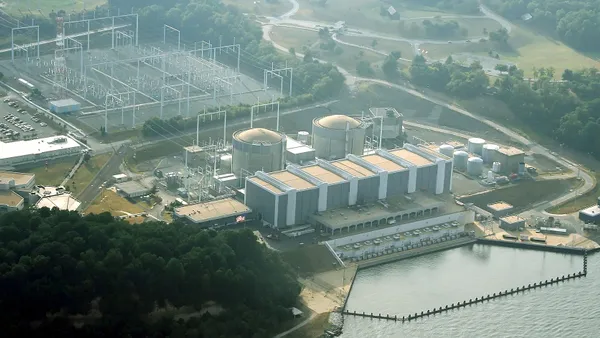Dive Brief:
-
Alliant Energy on Wednesday announced its commitment to net-zero carbon emissions from its electricity by 2050.
-
The "new aspirational goal" reduces carbon emissions 50% below 2005 levels by 2030 and eliminates all coal-fired power by 2040, 10 years faster than previously planned. Alliant owns or partially owns eight coal-fired power plants across Wisconsin and Iowa — three of which are slated for retirement or conversion to natural gas.
-
Environmentalists in the state criticized the utility for not moving fast enough, pointing to studies that have found retiring its coal plants in Wisconsin earlier could save customers more money.
Dive Insight:
Alliant's announcement follows growing commitments by investor-owned utilities to move toward a more low-carbon fuel mix. Xcel Energy, Madison Gas and Electric and Consumers Energy are among the other Midwest utilities to have made such a pledge.
Alliant owns two coal-fired plants in Wisconsin and in May announced plans to retire its 414 MW Edgewater Generating Station by 2022. The utility also owns capacity within six plants in Iowa, ranging from 32 MW to 348 MW, and totaling over 1 GW of generating capacity. Its 212 MW Burlington Generating Station will either retire by the end of 2021 or switch to gas-fired, and its 65 MW Prairie Creek Station will either retire or fuel switch by 2025.
| Plant | Nameplate Capacity | Retirement/Fuel Switch Date | Location |
|---|---|---|---|
| Ottumwa Generating Station | 348 MW | Not announced | Iowa |
| Lansing Generating Station | 275 MW | Not announced | Iowa |
| Burlington Generating Station | 212 MW | 2021 | Iowa |
| George Neal Generating Station (Units 3 and 4) | 343 MW | Not announced | Iowa |
| Prairie Creek Generating Station | 65 MW | 2025 | Iowa |
| Louisa Generating Station | 32 MW | Not announced | Iowa |
| Columbia Energy Center | 593 MW | Not announced | Wisconsin |
| Edgewater Generating Station | 414 MW | 2022 | Wisconsin |
In addition, the utility currently operates almost 3,000 MW of gas capacity between the two states, 90 MW of oil-fired power, over 1,100 MW wind, 43 MW of hydropower and 5 MW of solar. The majority of its wind power comes from Iowa and a large part of the utility's plan to decarbonize thus far in Wisconsin hinges on its plan to deploy up to 1,000 MW of solar in Wisconsin by 2023.
The utility did not announce a set level of renewable energy it would like to reach. Alliant reached its 30% renewables by 2030 goal this year and its "intention is keep adding renewables to our energy mix," utility spokesperson Scott Reigstad said in an email.
Alliant also said it may keep some natural gas-fired plants online, retrofitted with carbon capture or some other emissions-reducing technology, or it could also use carbon offsets to reach that goal.
"While our existing strategic plan guides us to our accelerated 2030 and 2040 sustainability goals, our 2050 goal of net-zero CO2 emissions from the electricity we generate is more aspirational and means our exact path to it is not entirely determined yet," said Reigstad.
In May, the utility announced plans to retire the last unit of its Edgewater coal plant, following the retirement of the plant's other two units in 2015 and 2018. The company told Utility Dive at the time it plans to retire that plant with primarily gas and solar generation.
Sierra Club found the unit lost $8.3 million in net energy market revenues in 2016, and in another report said Alliant's Wisconsin-based Columbia plant could cost $257 million through 2030. Alliant disputes the results of both studies, but environmentalists say the economic and climate trends are a sign the utility should shutter its remaining coal earlier than 2040.
"Scientific consensus is crystal clear that in order to mitigate the worst of climate change, the U.S. needs to retire their coal plants by 2030," Elizabeth Katt Reinders, deputy director of the Sierra Club's Beyond Coal Campaign for the North Central Region, told Utility Dive. Further, she said Alliant's Wednesday announcement was less a change in strategy and more a reflection of decisions the utility had already made, such as the Edgewater retirement and the solar additions.
Retiring the Columbia plant alongside the Edgewater plant could bring the utility more than halfway to its goal, and retiring its entire Iowa coal fleet by 2030 could reduce the company's total emissions 80% below 2005 levels, according to the Sierra Club.
Planning to shutter the Edgewater plant early was "an economically sound decision" and "the solar decision is game changing for Wisconsin ... but we are looking at this to say these emissions reductions goals do not go far enough fast enough," said Katt Reinders.
Alliant will "continue to evaluate and analyze the status of our coal facilities ... It is likely we will exit more coal facilities as well before 2040," Reigstad said.
Correction: Alliant owns capacity on coal plants in Iowa ranging from 32 MW to 348 MW. A previous version misrepresented these numbers.














